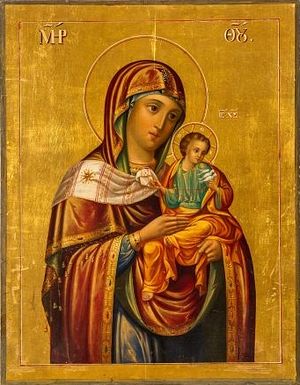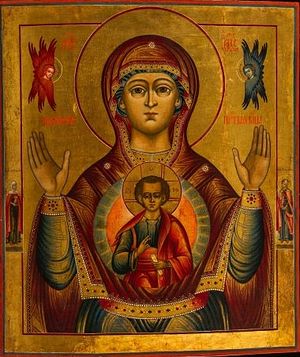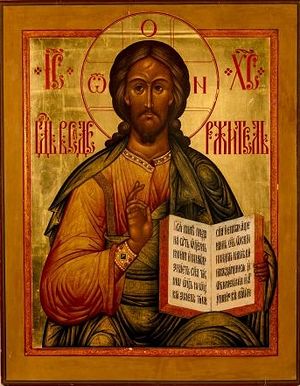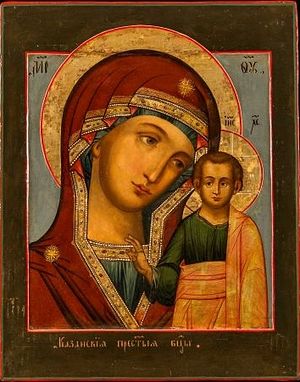SOURCE: ctpost.com
By Phyllis A.S. Boros
 |
| "Our Lady of the Doves" is included in "Windows into Heaven: Russian Icons & Treasures" at the Knights of Columbus Museum in New Haven. Photo: Contributed Photo |
Simply put: The appeal of Russian icons is international, extending beyond religious or ethnic background.
With this in mind, the museum at the Knights of Columbus' international headquarters in New Haven (where the organization was founded) has mounted "Windows into Heaven: Russian Icons & Treasures," which will be on view for more than a year -- through April 27, 2014.
The exhibition has opened in time for Orthodox Easter on Sunday, May 5. Many Orthodox Christian churches, including the Greek Orthodox and Russian Orthodox churches, celebrate Easter Sunday based on the Julian calendar.
The exhibition features about 325 icons and liturgical pieces, most of which are on loan from a private collector who has requested that his or her identity be withheld. A few pieces are from the museum's permanent collection.
Museum Curator Mary Lou Cummings said the exhibition is visually stunning no matter how one views iconography.
The exhibition points out that iconographic customs have endured for more than a millennium and "offer a story of spirituality, tradition and cultures, shaped by the triumphs and struggle of Russian Christians through their country's 12 centuries," according to information provided in the exhibition.
"Orthodox Christianity, adopted from the Byzantine Empire in Constantinople (now Istanbul), was instituted as the state religion in Kiev (modern Ukraine) by Prince Vladimir in 988 AD and spread across all of Russia. One of the most important elements of the Orthodox faith that followed from Constantinople was the sacred art of iconography," the museum said in a statement.

|
| "Our Lady of the Sign" is included in "Windows into Heaven: Russian Icons & Treasures" at the Knights of Columbus Museum in New Haven. Photo: Contributed Photo |
Prayer to, and veneration of, icons "was understood to be an encounter with God, his saints and angels," according to the exhibition's introductory text.
Members of the Orthodox faith consider icons as conduits for prayers or "windows into heaven" and "are not created to be artwork," Cummings added. Many of the icons on view are centuries old, thus predating the Bolshevik Revolution of the early 20th century, she said.
"Icons have been synonymous with Christian prayer and practice for centuries," said Supreme Knight Carl Anderson. "One of the great traditions of Eastern Christianity, icons are less well known here, and we are pleased that this exhibit will enable residents of the Northeast to grow in their understanding of the history and religious significance of these windows into heaven."
"Traditionally, icons were painted in egg tempera on wood and often accented with gold leaf or covered with ornately gilt metal covers called rizas. Rich in symbolism, they are still used extensively in Orthodox churches and monasteries, and many Russian homes have icons hanging on the wall in a beautiful (or prayer) corner. Today, Russian Orthodox icons are renowned throughout the world," according to the museum.
Cummings said the exhibition is presented in four distinct sections, each devoted to specific icons: Christ, Mother of God, Saints and Angels and Divine Liturgy.
|
|
Associated events
In conjunction with the exhibition, the museum will offer three free Saturday lectures, each at 2 p.m., by local iconographer Marek Czarnecki.
On the schedule are: "Iconography of the Mother of God," Saturday, May 25, and "Iconography: Tradition & History," Saturday, June 29.
pasboros@ctpost.com; http://www.twitter.com/PhyllisASBoros; www.ctpost.com/boros/
IF YOU GO
Knights of Columbus Museum, 1 State St, New Haven. Open daily from 10 a.m. to 5 p.m.; admission and parking are free. Call 203-865-0400 or visit kofcmuseum.org.
pasboros@ctpost.com; http://www.twitter.com/PhyllisASBoros; www.ctpost.com/boros/


